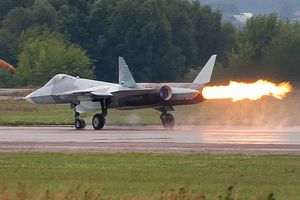After years of delay, India and Russia may be close to signing a detailed work-sharing agreement for the co-development and production of the the Sukhoi/HAL Fifth Generation Fighter Aircraft (FGFA), known in India as the Perspective Multi-role Fighter (PMF), according to Indian media reports.
Government officials involved in the negotiations told The Economic Times under the condition of anonymity that the agreement will be signed in 2017. “The contract for the detailed design would be signed soon and that will be a major milestone. It should be signed in the second half of the year,” a source said.
It remains unclear whether one of the most contentious issues—the transfer of sensitive defense technology from Russia to India–has been resolved. As I explained in March:
Before moving on, India wants a guarantee that Russia will be able to upgrade the fighter jet in the future without Russian support, which would require Moscow sharing source codes (sensitive computer code that controls the fighter jet’s various systems — the key to an aircraft’s electronic brains). In addition, the FGFA should directly support India’s advanced medium combat aircraft (AMCA) program—a separate Indian fifth generation fighter project.
Judging from the comment of an Indian government source, Russia appears to have acquiesced to the Indian demands. “We are co-developers. There is nothing called technology transfer in this project, “the source said. “India has equal rights. We will have the wherewithal to continue production. We are equal partner in the project.” Russia, however, has so far not publicly commented on the negotiations.
As I explained elsewhere, “the FGFA/PMF project has been hampered by repeated delays since the start of the project in 2007 and the signing of a preliminary $295 million design contract in 2010.” In addition, I noted:
Delays were caused by New Delhi and Moscow disagreeing over many fundamental aspects of the joint development project including work and cost share, aircraft technology, as well as the number of aircraft to be ordered. After evaluating the first PAK FA T-50 prototype (the Russian prototype of the PMF), the Indian Air Force (IAF) wanted more than 40 changes addressing, among other things, perceived weaknesses in the plane’s engine, stealth, and weapon-carrying capabilities.
Both sides also disagreed over the number of aircraft to be produced:
Russia announced in late 2015 that it would only induct a squadron (18-24 aircraft) of PAK FA fighter aircraft, and procure additional Sukhoi Su-35 aircraft instead. The original deal involved Russia procuring 250 and India 144 aircraft at a cost of around $30 billion by 2022. As a result, India threatened to abandon the project in its entirety. Russia in turn made a number of concessions including an offer to cut down its financial contribution from $6 to $ 3.7 billion for three PAK FA T-50 prototypes and substantial technology transfers.
On the technical side, Russia has been struggling to develop a new engine for the aircraft, which has also hampered India’s enthusiasm for the joint defense project.






























